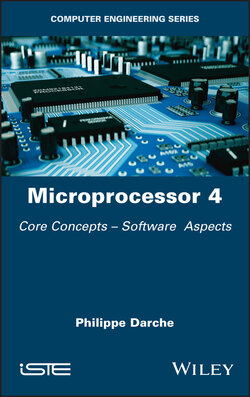Читать книгу Microprocessor 4 - Philippe Darche - Страница 33
1.2.4.5.1. Circular addressing
ОглавлениеDigital signal processing consists of digitizing samples xi (i ∈ [0, ∞]) of the signal that are stored in memory, then carrying out a mathematical processing such as filtering on them to then reconstruct the analog signal. To simplify the discourse, memorization of coefficients needed for the calculation is not attempted. The sample flow is of infinite length, and the calculation is only made on a limited number of consecutive samples on the sampled sequence. This set is called a “window”. Linear addressing of the buffer FIFO (First In, First Out) illustrated in Figure 1.23a is not well adapted as it is necessary to test whether the pointers have reached the end. Moreover, the size of the buffer is necessarily high. The circular buffer (ring or cyclic buffer, circular queue), that Figure 1.23b shows, is a much better solution as it makes it possible to decrease its size to that of the window of samples needed for the calculation.
Figure 1.23. Window of five samples
Circular or modulo addressing makes it possible to implement a circular buffer in a Random Access Memory (RAM). As shown in Figure 1.24, it is necessary to have four pieces of information that are the size of the circular buffer L, the address of the base of buffer B, the index pointer of the buffer I and increment (relative integer) M. This addressing uses modular arithmetic where the extent of the values is finite to calculate the pointer addresses. The benefit of using it lies in the fact that a block of L contiguous memory words is addressed by a pointer that uses a modulo addressing L. This means that once a pointer arrives at the end of a buffer, it is reinitialized to point the other end (more precisely, modulo addressing is the capacity to memorize the buffer).
Figure 1.24. Circular buffer
This is conveyed in algorithmic form by:
0 < |M| ≤ L
I ← I + M
if M > 0
then
1 if I ≥ B + L
2 then I ← I - L; buffer overflow or overflow from above
3 end_if
otherwise
1 if I < B
2 then I ← I + L; buffer overflow or overflow from below
3 end_if
4 end_if
Management logic detects a buffer overflow when there is a wraparound. It then generates an interrupt request (see Chapter 5) to warn the handler. This automatic management avoids a costly rearrangement of data by shifting them (Figure 1.25(a)) and a permanent monitoring of the pointer value to know whether it has reached an end of the buffer in order to reinitialize it. It frees useful calculating power for processing. For example, as soon as the top of the buffer is reached, the following sample is stored at its start (Figure 1.25(b)).
Figure 1.25. Comparison between linear and circular addressings (from Rao (2001))
The use domain is digital signal filtering carried out by a DSP where digital values, the results of a quantification of an analog signal, are stored in a delay line that can be implemented with a circular buffer in place of carrying out costly temporal shifts. The DSP ADSP-210xx family from Analog Devices uses this mode. One example of use is implementation of a Finite Impulse Response (FIR) described in § V3-5.2.
